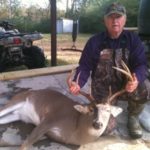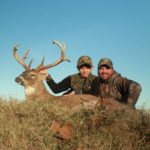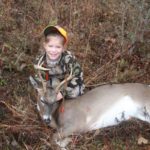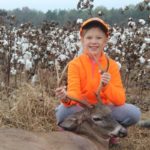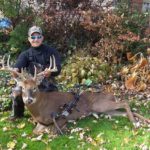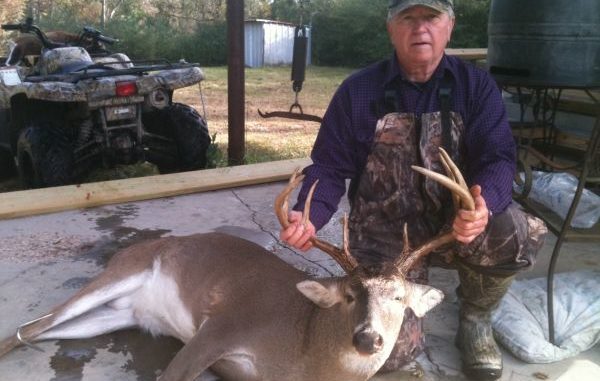
Think you know every deer living on your hunting club? Odds are you don’t — especially the old, mature bucks. Here are some thoughts on how to track them down and kill them.
I’ve known Bob Watson all my life.
His daughter and I grew up together, and she swore many years ago that her dad killed the buck hanging on their living room wall in a most unusual way.
Apparently, the buck was so close to his bow stand that he had no choice but to jump out of the tree, land squarely on the back of the buck and ride it like a horse while slicing it’s jugular vein.
And he had the scar under his nose where the buck’s brow tine split it when he landed.
I’m not sure how that particular deer died, but Watson was the stuff of legend around these parts.
Fortunately for me, he let me tag along on some of his trap lines.
He showed me where to nail my first makeshift wooden deer stand to a tree overlooking a fresh scrape.
And when rain threatened to cave in the sides of the hole where he was about to drop in a new swimming pool, I was right there with him, his daughter and son at midnight with shovel in hand.
Not much of his deer-hunting prowess rubbed off on me, though.
While I frequently came home with only stories to tell, Watson more often than not came home with a new head full of antlers.
Since it’s never too late to learn, I bugged him after church one Sunday about talking with me about some of his deer hunting tricks.
I knew it was going to be an easy interview when we were the last two left standing on the steps.
And, although I had never seen his new house in a subdivision just outside Franklinton, the corn scattered on the road left no doubt which house was his.
Over the years, Watson has made it a habit of killing big bucks on his properties that hardly anybody else would even know were there.
But his isn’t the only land that holds big bucks.
Even though you might not realize it, they’re right there on your own land.
You’ve just got to know where to look.
“They’re absolutely there,” Watson stressed. “But once the pressure is put on a deer, he’ll make him a hole somewhere, and that’s where he goes.”
“All those bucks you see during the summer don’t disappear. A dominant buck has his territory, and he supersedes everything else around. When the guns go to firing, he’ll slip into his hole and hide most of the hunting season in there.”
Watson turns to technology to pinpoint where dominant bucks might try to hide on his property, and he looks for something he called stem density.
To put it simply, stem density refers to how thick particular sections of a property are when viewed from above.
“An aerial map shows the trees and vegetation,” Watson said. “The densest spot you see from that view is where your biggest buck is going to hide.”
This densest spot could be in the form of a beaver-pond swamp, a mass of privet hedges or even right in plain sight on an old abandoned dairy farm that honeysuckle, sweet briars and bushes have reclaimed.
Then again, the thickest spot on your property can take on other forms, too.
Take water, for example.
“Water is a good place,” Watson went on. “A buck may lay up around a turkey pine — a spruce pine — where the bark keeps falling down every year. It winds up with a toadstool right around the base of the tree, and a buck will go right up there and bed around the side of that pine in a nice little spot.”
It’s a spot in which that old buck can have total confidence.
“He can lay there and snooze because he can hear anything and smell anything that gets close to him,” Watson said. “You walk in a swamp in boots, sloshing that old chalky clay up that smells like hydrogen sulfide — you blew it, buddy.
“He’ll hear you and smell (the clay), and you’ll never even realize he was there.”
And as far as pine plantations, which dominate many Louisiana tracts, Watson said they aren’t really the spots for big ghost bucks — unless yours happens to have an open spot with lots of 10-foot-tall briars.
“They’ll get in those briars and you can’t get him out,” Watson said. “He’s like a rabbit; you’ve got to step on him to make him move. If he goes 20 yards, that would be far. Most of the time, he just stays right there.
“Now, at night he’ll run in middle of the roads and work your food plots and show up in your backyard. He doesn’t have any boundaries until it gets daylight. Then he’s back in that spot.”
If you’re like me, you have some thick spots on your property that you know hold deer, but you aren’t too sure how to go about hunting them. So instead, you sit right on the edge of a food plot.
For Watson, the answer is easy.
“Wait for the rut,” he said. “There are some areas where you just can’t go to the deer because their sanctuary is just too thick.
“In that case, you’ve got to let them come to you, and the only time they’ll do that is during the rut when there is a doe standing in front of you.”
Because most of the big bucks Watson has killed made stupid mistakes chasing a doe, he is adamant about not shooting does in his plots.
Understanding that most people want to pull the trigger, he suggested killing your does on the trails leading to you plots rather than making such a mess and commotion right in the middle of your plot.
“If your does are comfortable in your plots, and one of them comes into heat — that’s when that buck you didn’t even know was there will do something stupid that’ll get him killed,” Watson said. “It’s only a small window of time, and you’ll be surprised at what you see. One buck might show up, or you might have three or four chasing that one doe.”
Even with the propensity of a buck to slip up when he has procreation on his mind, Watson believes that hunting, even during the rut, is 99 percent luck and 1 percent being there.
But, aside from hunting the rut, there’s got to be a way of targeting a big buck even when he doesn’t feel like coming out to play with the girls.
Watson feels there are two ways you might be able to get that split-second window when a big buck might cross paths with you.
“If you don’t want to wait on him to come to you during the rut,” he said, “I’d say go back to that stem density and find the thickest spot you can find, and hunt it from the outside in.
“Don’t go right in the middle of where you think he might be because you’ll blow him out and spend the rest of your season trying to find him again. It’s a lot easier to find him one time and play it safe.”
If you stay on the outside of thick cover, you stand a chance of him popping out or using a trail that you didn’t know was there.
But if you aren’t spotting him, Watson recommends gradually moving into the middle of it.
“Another way you might be able to spot him outside the rut is find the most-dense trail you can find that connects a thick bedding area with a thick feeding area,” he said. “Deer habitually walk the same trails, and if you can find where he slips through a thick trail, you can kill him.”
To prove his point, Watson related a story about a piece of property he used to hunt that featured a natural crossing through an area thick with brush and briars. The property owners wound up clear-cutting the spot — and, wouldn’t you know, the deer continued to walk the same trail even through it was now clear.
“The only difference was that they traveled it at night,” he added.
He drove home his point about finding a well-used trail by explaining that deer don’t just haphazardly run around. Rather, they move with a purpose.
And unless something drastic changes, they move with a purpose along the same trails they’ve always used.
Find that trail and set up high in a tree well off of it, and you’ll increase your chances of maybe getting a split-second opportunity to shoot that big buck.
Although this is all really good news regarding finding and hunting the most-dominant buck on your property, what Watson revealed last really hit home for somebody like me who hunts the same property year after year.
“If your biggest buck leaves your place and your neighbor winds up killing him, no big deal,” he said. “His offspring will move into that same area and take over. It’s kind of like that old saying about 90 percent of the fish living in 10 percent of the lake. Well, there’s something they like about that 10 percent of the lake that makes them want to be there.
“Deer are no different. What one big buck found attractive, another will, too. I’ve seen it time and time again with deer filling those spots.”
Just about that time, two big nanny does slipped into an opening behind an empty lot across the street from Watson’s house.
It was almost as if they knew he was talking about them.
They stood still and listened — and learned.
